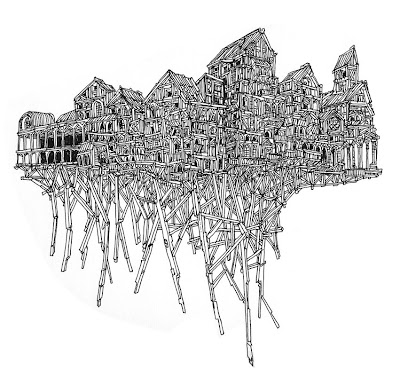
His recent New York gallery opening was touted (by the gallery) as a "visual tour de force." And Panter's own website announces that Panter is
"possibly the most influential graphic artist of his generation, a fact acknowledged by the Chrysler Design award he received..."It would take a lot of nerve to question the artistic judgment of Chrysler (which announced this week it had lost another half billion dollars due to its inability to design a decent car). Nevertheless, let's be brave and explore together:
Panter's web site proclaims that he "successfully broke down the barrier that separates 'trash' from 'art'...." Of course, previous artists have made similar claims. In 1961, Italian artist Piero Manzoni claimed that he successfully broke down the barrier that separates art from shit.

But I'm still not ready to concede that the barrier is completely gone. Perhaps the more interesting question is: which side of the barrier is Panter on?
Panter is a "cyber punk" artist, most famous as the creator of Jimbo, "a post-nuclear punk-rock cartoon character" who first appeared in the LA hardcore-punk paper Slash and later in RAW. Occasionally Panter creates a fine, strong image:

But most of the time, Panter produces the kind of art you'd expect to find in a decent high school literary magazine:



And all too often, Panter's work is (in my opinion) downright awful:



Genuine punk was never pretty, but at least it gained some legitimacy from its brute, energetic defiance. I love Johnny Rotten's response to the Rock and Roll Hall of Fame when it tried to honor the Sex Pistols:

What a fabulous message: "Were [sic] not coming. Your [sic] not paying attention." I doubt you would ever see Johnny Rotten bragging on his web site that the Chrysler Corporation had vouched for his artistic ability.
But the point of this post (and believe it or not, I do have one) is not to take a poke at an overrated artist or the the fans who fawn over such minor work. If "raw lunatic expression" is your game, artists such as Jean Dubuffet out-punk Panter by a mile.



Dubuffet's art embodied genuine rebellion. He preferred the art of the mentally ill to the work of classical artists. He wrote raging manifestoes about trashing all museums and abolishing culture. But despite his rebellious message, Dubuffet's drawings and paintings are still deeply beautiful. This is the most important difference between Panter and Dubuffet. Punk or no-punk, Panter is an artistic failure because he never seems to achieve (or even understand) some form of beauty. Regardless of the boldness of his color or line, his work is artistically anemic. He hasn't paid the dues required of those who seek to participate genuinely in form-creating activity.
And I'll even go one step further. For a man who is so eager to eliminate the barrier between art and trash, Panter repeatedly draws a bright line between his art and lowly "commercial" art. For this, commercial artists should be grateful. But it is a tired old cliche for Panter to suggest that illustration or other commercial forms of art can't be as raw as Panter's. Even within the straightjacket of commercial illustration, serious artists manage to look deeper into the abyss than Panter ever does. Panter's fans celebrate his "ratty line," but I don't find his line nearly as raw or unsettling as the truly scary linework in this spot illustration by commercial illustrator Robert Fawcett:

Take a close look at the violence and anarchy of Fawcett's line. For those with eyes to see, Panter is splashing around in a far shallower pool than Fawcett.
I have read the adulatory reviews of Panter's work, looking for help in finding what I am missing. So far, I cannot shake the conclusion that Panter is primarily an entertainer who tells amusing stories for people of a certain maturity level. Nothing wrong with that. But if that's the case, how do we explain all this attention to his work? My only explanation is that shallow, immature times call for shallow, immature art.




























